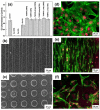Multi-Scale Surface Treatments of Titanium Implants for Rapid Osseointegration: A Review
- PMID: 32604854
- PMCID: PMC7353126
- DOI: 10.3390/nano10061244
Multi-Scale Surface Treatments of Titanium Implants for Rapid Osseointegration: A Review
Abstract
The propose of this review was to summarize the advances in multi-scale surface technology of titanium implants to accelerate the osseointegration process. The several multi-scaled methods used for improving wettability, roughness, and bioactivity of implant surfaces are reviewed. In addition, macro-scale methods (e.g., 3D printing (3DP) and laser surface texturing (LST)), micro-scale (e.g., grit-blasting, acid-etching, and Sand-blasted, Large-grit, and Acid-etching (SLA)) and nano-scale methods (e.g., plasma-spraying and anodization) are also discussed, and these surfaces are known to have favorable properties in clinical applications. Functionalized coatings with organic and non-organic loadings suggest good prospects for the future of modern biotechnology. Nevertheless, because of high cost and low clinical validation, these partial coatings have not been commercially available so far. A large number of in vitro and in vivo investigations are necessary in order to obtain in-depth exploration about the efficiency of functional implant surfaces. The prospective titanium implants should possess the optimum chemistry, bionic characteristics, and standardized modern topographies to achieve rapid osseointegration.
Keywords: macro-scale; micro-scale; nano-scale; rapid bone integration; roughness; surface modification.
Conflict of interest statement
The authors declare no conflict of interest.
Figures








Similar articles
-
Nano-scale modification of titanium implant surfaces to enhance osseointegration.Acta Biomater. 2019 Aug;94:112-131. doi: 10.1016/j.actbio.2019.05.045. Epub 2019 May 22. Acta Biomater. 2019. PMID: 31128320 Review.
-
Surface treatments of titanium dental implants for rapid osseointegration.Dent Mater. 2007 Jul;23(7):844-54. doi: 10.1016/j.dental.2006.06.025. Epub 2006 Aug 14. Dent Mater. 2007. PMID: 16904738 Review.
-
Influence of acid-etching after grit-blasted on osseointegration of titanium dental implants: in vitro and in vivo studies.J Mater Sci Mater Med. 2013 Aug;24(8):2047-55. doi: 10.1007/s10856-013-4935-0. Epub 2013 Apr 27. J Mater Sci Mater Med. 2013. PMID: 23625320
-
Novel hydrophilic nanostructured microtexture on direct metal laser sintered Ti-6Al-4V surfaces enhances osteoblast response in vitro and osseointegration in a rabbit model.J Biomed Mater Res A. 2016 Aug;104(8):2086-98. doi: 10.1002/jbm.a.35739. Epub 2016 May 4. J Biomed Mater Res A. 2016. PMID: 27086616
-
Enhanced osseointegration of titanium implants with nanostructured surfaces: an experimental study in rabbits.Acta Biomater. 2015 Jan;11:494-502. doi: 10.1016/j.actbio.2014.10.017. Epub 2014 Oct 23. Acta Biomater. 2015. PMID: 25449926
Cited by
-
Mapping Bone Marrow Cell Response from Senile Female Rats on Ca-P-Doped Titanium Coating.Materials (Basel). 2022 Jan 30;15(3):1094. doi: 10.3390/ma15031094. Materials (Basel). 2022. PMID: 35161039 Free PMC article.
-
Effects of fluid shear stress on expression of focal adhesion kinase in MG-63 human osteoblast-like cells on different surface modification of titanium.Bioengineered. 2021 Dec;12(1):4962-4971. doi: 10.1080/21655979.2021.1962686. Bioengineered. 2021. PMID: 34374319 Free PMC article.
-
Comparison Between Micro- and Micro-Nano Surface Texturization in the Initial Osseointegration Process: An Experimental In Vitro and In Vivo Preclinical Study.Bioengineering (Basel). 2025 Feb 12;12(2):175. doi: 10.3390/bioengineering12020175. Bioengineering (Basel). 2025. PMID: 40001694 Free PMC article.
-
Proteomic evaluation of human osteoblast responses to titanium implants over time.J Biomed Mater Res A. 2023 Jan;111(1):45-59. doi: 10.1002/jbm.a.37444. Epub 2022 Aug 30. J Biomed Mater Res A. 2023. PMID: 36054528 Free PMC article.
-
Collagen-Based Osteogenic Nanocoating of Microrough Titanium Surfaces.Int J Mol Sci. 2022 Jul 15;23(14):7803. doi: 10.3390/ijms23147803. Int J Mol Sci. 2022. PMID: 35887152 Free PMC article.
References
-
- Xiao L., Wu S., Liu B., Yang H., Yang L. Advances in metallic biomaterials with both osteogenic and anti-infection properties. ACTA Metall. Sin. 2017;53:1284–1302.
Publication types
Grants and funding
LinkOut - more resources
Full Text Sources
Miscellaneous

